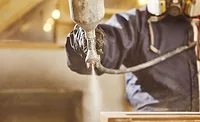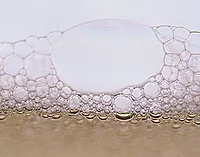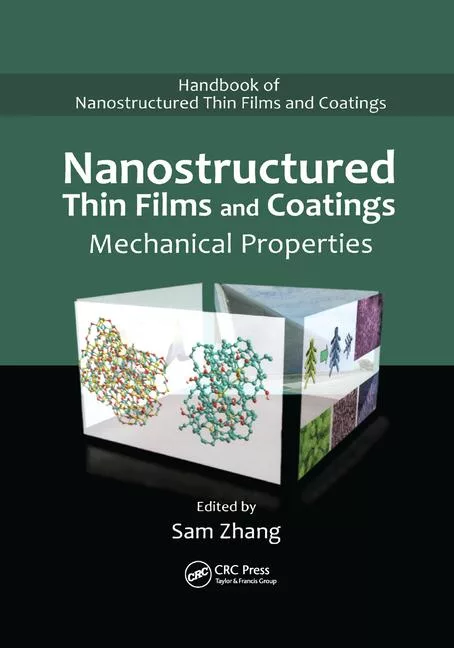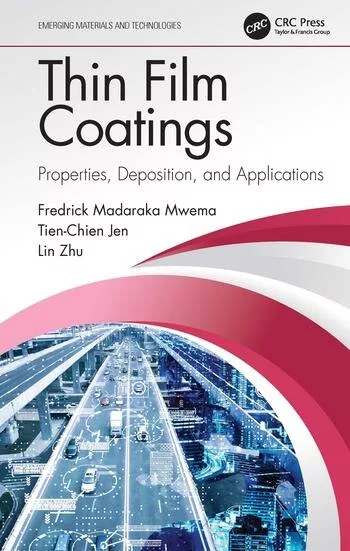Can a Solvent-Free Hybrid Meet Performance Demands?
Low-VOC Amine-Free Waterborne Polyurethane/Acrylic Hybrid Resin

Credit: LightStock / iStock via Getty Images Plus
Waterborne polyurethane dispersions (PUDs) have long been valued in the coatings industry for their remarkable film-forming capabilities, toughness and flexibility. These attributes make them a popular choice for various applications ranging from industrial finishes to consumer goods.¹ However, PUDs are not without their challenges. Poor early water resistance and relatively high production costs limit their utility in certain demanding environments, especially where both performance and cost-effectiveness are critical. As industries increase focus on sustainable and environmentally friendly solutions, there is a pressing need to address these limitations.
One promising approach to overcoming the drawbacks of PUDs lies in the development of polyurethane/acrylic (PUA) hybrid resins.² These hybrids combine the complementary strengths of polyurethane and acrylic technologies, offering a balance of properties that neither component can achieve alone. By leveraging the toughness of polyurethanes and the excellent water and chemical resistance of acrylics, PUAs may deliver coatings with superior durability, performance and versatility. Additionally, their cost effectiveness makes them an attractive alternative for high-performance applications, particularly in industries with tight budgetary and environmental constraints.
This study introduces solvent-free PUA hybrid resins designed to meet modern coating challenges. The resins support formulations with low volatile organic compound (VOC) levels while balancing hardness with flexibility and ensuring good film coalescence even under demanding conditions. Their amine-free design addresses issues like amine migration and yellowing, enhancing stability, durability and aesthetics of the coatings. In addition to environmental benefits, these resins offer robust solvent resistance and strong adhesion to various substrates, making them versatile for protective and decorative applications.
Experimental and Characterization
Unless otherwise specified, a screening formulation with a consistent VOC level of Dowanol DPM as the coalescing agent, supplemented with appropriate additives, was used to ensure defect-free sample preparation for all evaluations.
Glass Transition Temperature (Tg)
The glass transition temperatures were determined using a Netzsch DSC 214 Polyma differential scanning calorimeter (DSC). Pristine waterborne resin samples were dried at ambient temperature for seven days before being placed into the DSC pan. Measurements were performed from −60 °C to 250 °C at a heating rate of 5 °C/min under a nitrogen atmosphere.
Dry Time
A 3 mil thick wet film of the resin using the screening formulation was prepared on a Leneta 2810 chart and immediately placed on a Gardco circular dry timer. The four stages of drying were determined in accordance with ASTM D5895.
Gloss Measurement
Gloss was assessed by applying a 3 mil thick wet film of the resin from the screening formulation onto a Leneta 2810 chart and allowing it to dry overnight at ambient temperature. Gloss values were measured using a BYK Micro TRI gloss meter at 60°. Each reported value is the average of three measurements.
Hardness Testing
Resin hardness was evaluated using a BYK Gardner 5844 pendulum damping tester in accordance with ASTM D4366-16. Coatings using the screening formulation were applied to glass panels (100 mm × 75 mm) using a cubic applicator (BA45) to achieve a wet film thickness of 3 mil and then dried under ambient conditions.
Early Water Resistance
Early water resistance was assessed by applying a 3 mil thick wet film of the resin from the screening formulation onto a Leneta 2810 chart and allowing it to dry for one day at ambient temperature. Three drops of deionized water were pipetted onto the film without covering, and the coating was visually inspected after one hour for defects such as wrinkling, blistering, swelling, whitening or softening. The ratings were assigned as follows: 5 - no visible effect; 4 - slight stain, softness, swelling or whitening that recovers within one hour; 3 - slight blistering, swelling; 2 - moderate blistering; 1 - severe blistering or wrinkling. The surface was re-evaluated one hour later for the same defects. This procedure was repeated at three days and seven days after the initial drawdown.
Chemical Resistance
Chemical resistance was assessed by applying a 3 mil thick wet film of resin from the screening formulation onto a 12 in × 9 in glass plate and curing it for seven days at ambient temperature. Drops of selected chemicals or household products were placed on small pieces of cheesecloth, which were then positioned on the coating and covered with a watch glass. The coatings were assessed for defects after 24 h of exposure and re-evaluated one hour later. The ratings were assigned as follows: 5 - no visible effect; 4 - slight stain, softness, swelling or whitening that recovers within one hour; 3 - slight blistering, swelling; 2 - moderate blistering; 1 - severe blistering or wrinkling; 0 - dissolved.
Abrasion Resistance
The coatings made via the screening formulation were applied to aluminum chromate panels at a natural spread rate, with three coats brushed on and allowed to dry for 24 h between applications. After the final coat, panels were cured at ambient temperature for seven days before testing. The abrasion resistance of the dried coatings was evaluated using a Taber Abraser, following ASTM D4060-10. Each specimen was tested using a pair of Calibrase CS-17 abrasive wheels with an auxiliary mass of 1000 g per wheel, rotating at 72 rpm. The wheels were resurfaced before testing each specimen and after every 500 cycles. A vacuum system was employed during testing to remove debris. Mass loss was recorded every 500 cycles for a total of 1000 cycles.
Blocking Performance
Blocking resistance was tested following ASTM D4946. A 3 mil thick wet film from the screening formulation was applied to a Leneta 2813 chart and dried for one day at ambient temperature. The coated film was cut into 1.5 in × 1.5 in squares, paired face-to-face and subjected to a 1000 g weight at either ambient temperature or 120 °F for one hour. The degree of blocking was rated using the ASTM scale. The testing was repeated after seven days. All measurements were performed in triplicate.
Adhesion Performance
Adhesion performance on various substrates, including smooth aluminum, cold-rolled steel, hot-dip galvanized steel and smooth concrete, was assessed following ASTM D3359. A 3 mil thick wet film of the resin with 50 g/L VOC of Dowanol DPM (without other additives) was applied to each substrate and cured at ambient temperature for one and seven days. Dry adhesion on metal substrates was evaluated with a 1 mm crosshatch width, while adhesion on smooth concrete was tested with a 3 mm crosshatch width. The reported adhesion ratings represent the average of two tests for each substrate.
Results and Discussion
PUA1 and PUA2 are two aliphatic PUA hybrid resin dispersions synthesized in a zero-VOC, amine-free process via emulsion polymerization of PU polymers with acrylic monomers. The major difference between PUA1 and PUA2 resin polymers is the type and molecular weight of the polyol in their PU block. The representative properties of PUA dispersions are summarized in Table 1.
TABLE 1 | Properties of PUA dispersions.
A series of advanced PUD and acrylic resins was utilized as benchmarks for comparison with PUAs. PUD1 is a premium PUD that is both solvent- and emulsifier-free. It offers balanced flexibility, exceptional gloss and hardness, making it ideal for high performance decorative, industrial wood and construction finishes. PUD2 is a market-leading oxygen-crosslinking waterborne wood finish designed for interior residential and commercial floors. It is widely recognized for its durability and performance. PUD3 is a dual self-crosslinking, fatty acid-modified PUD enabling low-VOC, warm-toned varnishes with outstanding abrasion resistance for single-pack applications. Acrylic1 is a surfactant-free, fast drying, self-crosslinking aqueous dispersion of acrylic resin designed for highly durable furniture finishes. PU-A is a blend of PUD and acrylic resins suitable for industrial wood applications, and it has a similar PU/acrylic ratio to the PUAs. The key differences of the resin dispersions are highlighted in Table 2.
TABLE 2 | Comparative characteristics of resin dispersions.
Similar to PUDs, PUA1 and PUA2 demonstrated a fast-drying rate, achieving dry-through within 40 min under ambient conditions (Table 3). Additionally, the PUA resins demonstrated high gloss potential, comparable to that of PUDs (Figure 1). No significant changes in gloss were observed after seven days of drying.
TABLE 3 | Drying time comparison of PUA and PUD resins using the screening formulation.
FIGURE 1 | Gloss (60°) comparison of PUA and PUD resin films on Leneta 2810 chart after drying for one and seven days using the screening formulation.
Figure 2 illustrates the König hardness development of the resins using the screening formulation during drying at ambient conditions over seven days. The PUA1 film showed a relatively fast increase in hardness, reaching 83 s after seven days. In contrast, the PUA2 and PUD3 films exhibited lower hardness after seven days of drying due to the use of more flexible polyols in their PU formulation. PUD1 exhibited exceptional hardness despite the lack of self-crosslinking, which can be attributed to its high hard segment content and the steric hindrance provided by its specific polyol and isocyanate combination. PUD2 also showed rapid hardness development, likely driven by enhanced self-crosslinking facilitated by the inclusion of a drying accelerator in this commercial formulation. Notably, the development of König hardness is strongly influenced by the drying conditions and the choice of coalescing agent. Without the use of the coalescing agent Dowanol DPM, PUA1 achieved König hardness of approximately 103 s after drying the pristine resin at ambient conditions for one day.
FIGURE 2 | König hardness development of PUA and PUD resins using the screening formulation.
Achieving high early water resistance is a significant challenge for PUD resins, primarily due to the use of internal or external emulsifiers to disperse PU in water. Incorporating specific hydrophobic acrylics into PU to form a hybrid resin is expected to improve early water resistance, given the inherently good water resistance of these acrylics. This enhancement is evident when comparing the early water resistance of PUA and PUD resins (Table 4). After one hour of water exposure, the 1-day dried PUA1 and PUA2 films exhibited only slight swelling, whereas the PUD films showed more pronounced swelling or blistering. Notably, after three days of drying, the PUA1 and PUA2 films remained unaffected by one hour of water exposure, while the PUD films continued to slightly swell.
TABLE 4 | Early water resistance of PUA and PUD resins using the screening formulation (Score ratings: 5 - no visible effect; 4 - slight stain, softness, swelling or whitening that recovers within one hour; 3 - slight blistering, swelling).
The chemical resistance of PUA resins was assessed against common household liquids, acids and bases. After drying the screening formulations for seven days under ambient conditions, the resin films were exposed to the test materials for 24 h. As shown in Figure 3a, the PUA resins exhibited great resistance to common household liquids, oils and acids but were less resistant to detergents and bases. Overall, their chemical resistance was comparable to, or slightly better than, that of the high-performance PUD benchmarks (Figure 3b). Among the PUAs and PUDs, PUA1 demonstrated the best overall chemical resistance, likely due to the relatively high rigidity of its PU block and the enhanced water resistance provided by its acrylic components.
FIGURE 3 | Chemical resistance of PUA and PUD dried films. a) Individual scores of PUA and PUD dried films against 10 common household products (score ratings: 5 - no visible effect; 4 - slight stain, softness, swelling or whitening that recovers within one hour; 3 - slight blistering, swelling; 2 - moderate blistering; 1 - severe blistering or wrinkling; 0 – dissolved); b) Composite chemical resistance scores of PUA and PUD dried films (maximum composite score = 50, indicating no visible effect for all 10 common household products).
Figure 4 compares the abrasion resistance of PUA with PUD, acrylic and a PU-acrylic resin blend with a similar PU/acrylic ratio to PUA. The PUAs demonstrated good abrasion resistance, with a weight loss of approximately 50–60 mg per 1000 cycles. While Acrylic1 exhibited a relatively high weight loss of about 105 mg per 1000 cycles, PUDs showed a broader range of abrasion resistance, with weight loss varying from 34 to 107 mg per 1000 cycles. PUD1 demonstrated exceptional abrasion resistance due to its balanced flexibility and high hardness achieved through optimized polyol selection and elevated isocyanate content, which significantly enhanced its toughness and hardness. The PU-acrylic blend showed a weight loss of 92 mg per 1000 cycles, which was higher than that of PUAs. These results highlight the advantage of PUA hybrids over blends, attributed to the interpenetrating network of acrylic and urethane polymer chains at the molecular level, which enhances acrylic-polyurethane phase compatibility and overall performance.³
FIGURE 4 | Abrasion loss comparison of different resins using the screening formulation.
The block resistance of PUA and PUD resins is compared in Figure 5. At ambient temperature (Figure 5a), all dried resins obtained from the screening formulation demonstrated no tack during the 1 h block resistance test. With an extended drying time of seven days, the block resistance of all resins at elevated temperatures improved. After heating at 120 °F for one hour, PUA1, PUA2 and PUD3 showed very slight to slight tack, outperforming PUD1 (Figure 5b). This highlights the advantages of self-crosslinking in enhancing the block resistance of these resins at elevated temperatures.
FIGURE 5 | Block resistance comparison of PUA and PUD resins using the screening formulation. a) Tested at 72 °F for 1 h after drying the resins for 1 and 7 days; b) Tested at 120 °F for 1 h after drying the resins for 1 and 7 days (scores: 0–10, with 10 indicating no tack).
Due to its relatively low Tg, PUA2 was further evaluated for low-temperature film formation in low-VOC applications. A 3 mil thick wet film of PUA2, containing 50 g/L VOC (Dowanol DPM) without other additives, applied to a glass panel and dried overnight at 40 °F with 50% humidity, successfully formed a defect-free film. A ladder study indicated that the VOC content (Dowanol DPM) for PUA2 could be further reduced to approximately 25 g/L while maintaining good film formation at 40 °F with 50% humidity. Given that the PUA2 resin is inherently solvent-free and VOC-free, combined with its exceptional low-temperature film formation capability, it could be an excellent candidate for low-VOC coating applications.
The adhesion of PUA2 on various substrates was also evaluated using the cross-hatch test (Table 5). A 3 mil thick wet film was applied to each substrate and cured at ambient temperature for 24 h. No additional additives other than Dowanol DPM (50 g/L VOC) were used in the resin formulation to eliminate any influences from other additives. Without the use of any surface adhesion promoter, the PUA2 resin demonstrated good adhesion on all tested metal and concrete substrates. Curing for seven days improved its adhesion on the concrete substrate further.
TABLE 5 | Adhesion performance of PUA2 on different substrates.
Conclusion
This study presents zero-VOC polyurethane/acrylic hybrid waterborne resins designed to meet increasingly stringent environmental and performance demands. Synthesized without auxiliary solvents, these PUA resins enable the formulation of low-VOC coatings while achieving an optimal balance of hardness, gloss and excellent low-temperature coalescence properties. Their amine-free resins demonstrate robust solvent resistance and strong adhesion to a wide variety of substrates, making them versatile candidates for diverse industrial applications.
The authors thank their Allnex colleagues Irina Kobylanska, Anton Arzt and George Fortman for their valuable insights and discussions.
References
1 Honarkar, H. Waterborne Polyurethanes: A Review. J. Dispers. Sci. Technol. 2018, 39, 507–516.
2 Mehravar, S.; Ballard, N.; Tomovska, R.; Asua, J. M. Polyurethane/Acrylic Hybrid Waterborne Dispersions: Synthesis, Properties and Applications. Ind. Eng. Chem. Res. 2019, 58, 20902–20922.
3 Peruzzo, P.; Anbinder, P.; Pardini, O.; Vega, J.; Costa, C.; Galembeck, F.; Amalvy, J. Waterborne Polyurethane/Acrylate: Comparison of Hybrid and Blend Systems. Prog. Org. Coat. 2011, 72, 429–437.
Looking for a reprint of this article?
From high-res PDFs to custom plaques, order your copy today!









